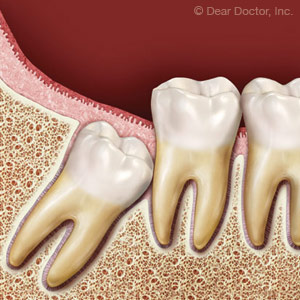As Spring turns to Summer, millions of students will depart high school in the time-honored rite of passage called graduation. At the same time, quite a few of these graduates will be experiencing another maturity milestone: the eruption (coming in) of their last permanent teeth.Typically, these are the back third molars, better known as “wisdom teeth,” emerging on either end of both the top and bottom jaws sometime between the ages of 18 and 24. Their arrival heralds the end of a long development process that began in infancy.But this auspicious event can give rise to dental problems. Because they’re the last to come in, wisdom teeth often erupt in an environment crowded by earlier teeth. Depending on jaw size and other factors, there may not be enough room for a normal eruption.Wisdom teeth can thus erupt out of position, creating a poor bite (malocclusion). Or they might not erupt at all—becoming stuck fully or partially within the gums and bone, a condition known as impaction. Impacted teeth can also cause problems for the adjacent teeth, damaging the roots of the second molars or disrupting the surrounding gum tissue, making them more susceptible to periodontal (gum) disease.Because of these and other issues, impacted wisdom teeth are among the most common type of teeth removed: an estimated 10 million each year. And many of these are removed before they show signs of disease or complications as a preemptive strike against developing dental problems.Although unnecessary surgery should always be avoided, according to some research, there’s a one in three chance that erupting wisdom teeth that are not showing signs of trouble will eventually become problematic. And the earlier they’re removed, the lower the risk of post-extraction complications.Wisdom teeth should always be evaluated on a case by case basis. Those with obvious signs of disease or complications do require prompt treatment, including possible extraction. Others that are asymptomatic can be monitored over time: If they’re tending to become problematic, we can adjust the treatment plan accordingly. Our goal is to ensure these particular teeth signaling the end of childhood won’t detract from dental health in adulthood, so a measured approach seems to be the best and safest one.If you would like more information on treatment options for wisdom teeth, please contact us or schedule an appointment for a consultation. To learn more, read the Dear Doctor magazine articles “Wisdom Teeth: Coming of Age May Come With a Dilemma” and “Wisdom Teeth: To Be or Not to Be?”
Wisdom Teeth and What to Do About Them
by Norwich Aesthetic Dentistry | Jun 18, 2019 | Dental Procedures

